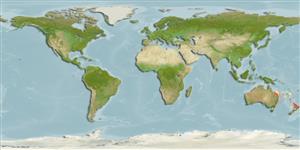Environment: milieu / climate zone / depth range / distribution range
Écologie
marin benthopélagique; profondeur 10 - 450 m (Ref. 9563). Subtropical; 19°S - 41°S, 148°E - 178°W
Western Pacific: eastern Australia from western Bass Strait and northeastern Tasmania to Moreton Bay, Queensland. Also found in New Zealand; recently recorded from the Chesterfield Islands and New Caledonia (Ref. 9833).
Length at first maturity / Taille / Poids / Âge
Maturity: Lm 22.5, range 20 - 25 cm
Max length : 51.0 cm SL mâle / non sexé; (Ref. 33987); poids max. publié: 2.0 kg (Ref. 9833)
Épines dorsales (Total): 6 - 7; Rayons mous dorsaux (Total): 11-13; Épines anales 4; Rayons mous anaux: 12; Vertèbres: 24
Occur on rocky reefs and muddy substrates of the continental shelf and upper slope, forming dense schools close to the bottom at dawn and dusk and dispersing throughout the water column at night to feed (Ref. 9563). Juveniles also aggregate in schools (Ref. 33987) and are found in estuaries and shallow costal waters (Ref. 9833). Feed on small fish, crustaceans and mollusks (Ref. 27111).
Life cycle and mating behavior
Maturité | Reproduction | Frai | Œufs | Fécondité | Larves
Paxton, J.R., 1999. Berycidae. Alfonsinos. p. 2218-2220. In K.E. Carpenter and V.H. Niem (eds.) FAO species identification guide for fishery purposes. The living marine resources of the WCP. Vol. 4. Bony fishes part 2 (Mugilidae to Carangidae). FAO, Rome. (Ref. 9833)
Statut dans la liste rouge de l'IUCN (Ref. 130435)
Menace pour l'homme
Harmless
Utilisations par l'homme
Pêcheries: commercial
Plus d'informations
RéférencesAquacultureProfil d'aquacultureSouchesGénétiqueElectrophoresesHéritabilitéPathologiesTraitementNutrientsMass conversion
CollaborateursImagesStamps, Coins Misc.SonsCiguateraVitesseType de nageSurface branchialeOtolithesCerveauxVision
Outils
Articles particuliers
Télécharger en XML
Sources Internet
Estimates based on models
Preferred temperature (Ref.
123201): 14.1 - 20.5, mean 15.9 °C (based on 22 cells).
Phylogenetic diversity index (Ref.
82804): PD
50 = 0.5088 [Uniqueness, from 0.5 = low to 2.0 = high].
Bayesian length-weight: a=0.01259 (0.00571 - 0.02773), b=3.04 (2.85 - 3.23), in cm total length, based on LWR estimates for this (Sub)family-body shape (Ref.
93245).
Niveau trophique (Ref.
69278): 3.8 ±0.59 se; based on food items.
Generation time: 14.7 ( na - na) years. Estimated as median ln(3)/K based on 2
growth studies.
Résilience (Ref.
120179): Milieu, temps minimum de doublement de population : 1,4 à 4,4 années (K=0.25; tm=4; tmax=16).
Prior r = 0.43, 95% CL = 0.27 - 0.68, Based on 1 stock assessment.
Fishing Vulnerability (Ref.
59153): High to very high vulnerability (70 of 100).
Climate Vulnerability (Ref.
125649): High vulnerability (64 of 100).
Nutrients (Ref.
124155): Calcium = 41.4 [12.4, 125.0] mg/100g; Iron = 0.724 [0.333, 1.367] mg/100g; Protein = 17.8 [16.8, 18.9] %; Omega3 = 0.431 [0.177, 0.992] g/100g; Selenium = 41.3 [21.8, 78.9] μg/100g; VitaminA = 20.2 [6.8, 63.7] μg/100g; Zinc = 0.733 [0.506, 1.093] mg/100g (wet weight);
